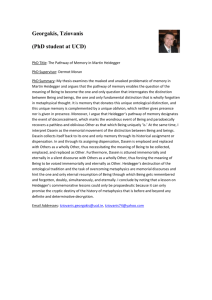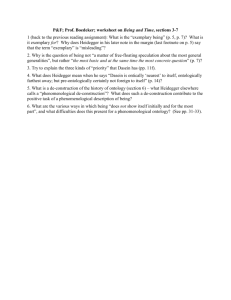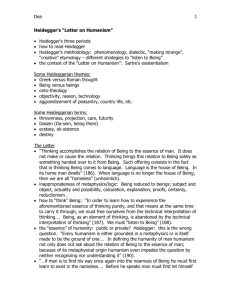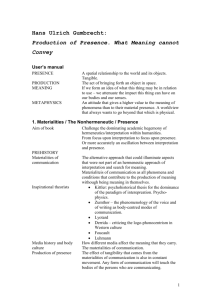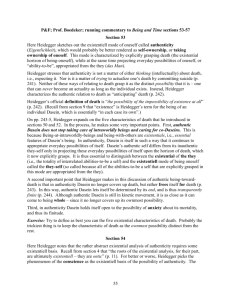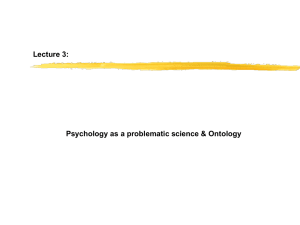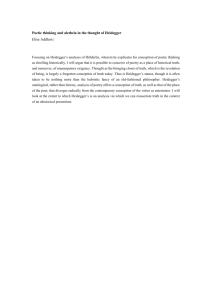Michael Bowler Michigan Technological University
advertisement
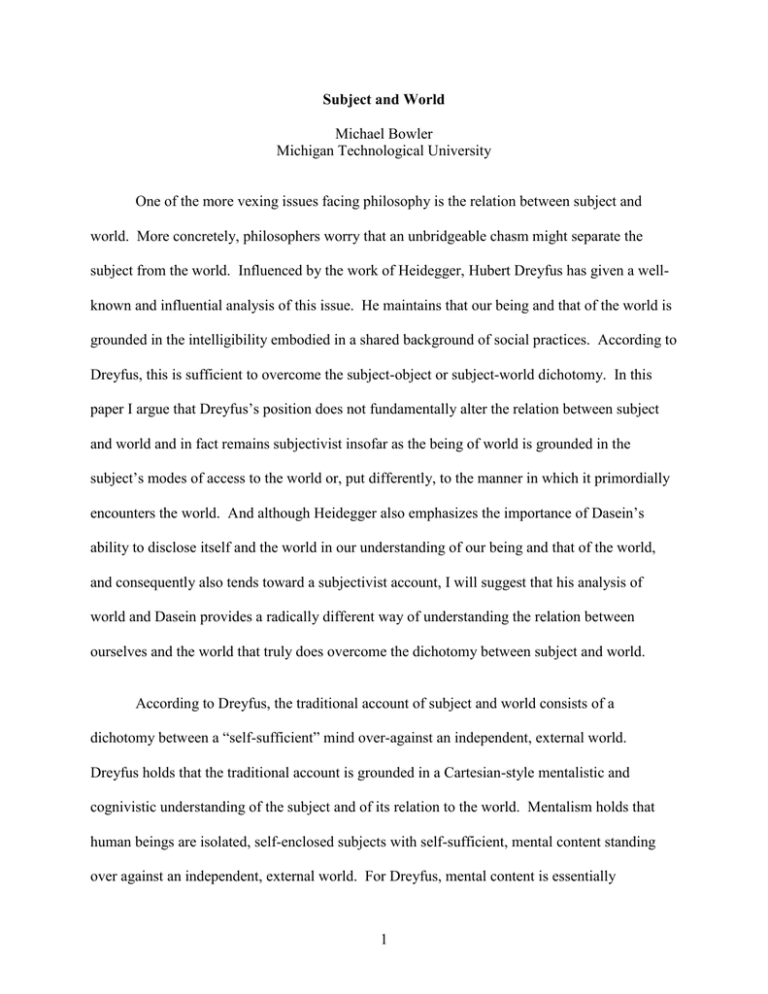
Subject and World Michael Bowler Michigan Technological University One of the more vexing issues facing philosophy is the relation between subject and world. More concretely, philosophers worry that an unbridgeable chasm might separate the subject from the world. Influenced by the work of Heidegger, Hubert Dreyfus has given a wellknown and influential analysis of this issue. He maintains that our being and that of the world is grounded in the intelligibility embodied in a shared background of social practices. According to Dreyfus, this is sufficient to overcome the subject-object or subject-world dichotomy. In this paper I argue that Dreyfus’s position does not fundamentally alter the relation between subject and world and in fact remains subjectivist insofar as the being of world is grounded in the subject’s modes of access to the world or, put differently, to the manner in which it primordially encounters the world. And although Heidegger also emphasizes the importance of Dasein’s ability to disclose itself and the world in our understanding of our being and that of the world, and consequently also tends toward a subjectivist account, I will suggest that his analysis of world and Dasein provides a radically different way of understanding the relation between ourselves and the world that truly does overcome the dichotomy between subject and world. According to Dreyfus, the traditional account of subject and world consists of a dichotomy between a “self-sufficient” mind over-against an independent, external world. Dreyfus holds that the traditional account is grounded in a Cartesian-style mentalistic and cognivistic understanding of the subject and of its relation to the world. Mentalism holds that human beings are isolated, self-enclosed subjects with self-sufficient, mental content standing over against an independent, external world. For Dreyfus, mental content is essentially 1 characterized by its propositional structure and is embodied in mental states of the subject. 1 Cognitivism maintains that any explanation of human thought and activity must ultimately appeal to explicit or implicit mental states and systems of such states, namely, “theories,” and to the content of such states.2 Dreyfus argues that the proper antidote to this traditional misunderstanding of the subject is a thoroughly socialized account of human being, one for which our understanding of ourselves and the world lies in the essentially implicit intelligibility embodied in our absorbed, skillful coping. Skillful, absorbed coping is, as Joseph Rouse has succinctly put it, “the mostly smooth and unobtrusive responsiveness to circumstances that enables human beings to get around in the world.”3 And we are able to skillfully cope in an absorbed manner by means of our socialization into a shared background of social practices and skills, which is not the process of imparting to a self-sufficient, isolated mind a theory about the world. Socialization creates a human organism that embodies a holistic set of practices and skills. Socialization fashions an organism that is capable of responding unthinkingly, yet appropriately to people, things, situations, etc. A human organism is not a human being (or Dasein) until it begins to become socialized into its society’s shared background of social practices and skills, and especially the for-the-sake-of-whichs included therein.4 Or put succinctly Human beings are socialized human organisms. Our shared background of social practices and skills not only permeates and determines the being of Dasein, but also that of the world and everything encountered within it. According 1 See, for instance, Dreyfus (2001), pg. 183 and Blattner (2007), pp. 10 - 27. Thus, according to Dreyfus (1991a), the cognitivist stubbornly maintains that “everything human beings do … is based on an implicit theory … [and] leads to the view that even if a background of shared practices is necessary for intelligibility, one can rest assured that one will be able to analyze that background in terms of further mental states. Insofar as background practices contain knowledge, they must be based on implicit beliefs; insofar as they are skills they must be based on tacit rules.” (pg. 5) 3 Rouse (2000), pg. 8. 4 Dreyfus (1991a), pp. 23 – 24. In fact, a baby begins to become a human being, according to Dreyfus, “only after the first few weeks.” 2 2 to Dreyfus we primordially disclose ourselves and the world by means of the general, holistic background coping that allows one to be “ready in particular circumstances to respond appropriately to whatever might normally come along.”5 For example, when we are able to make our way around a workshop, living room, or tennis court. This makes possible our discovery of entities within the world, e.g., particular pieces of equipment. The upshot is that it is a shared background of social practices and skills that provide for and ground the intelligibility, meaning, and, in fact, the very being of Dasein, the world and everything within the world. In general, Dreyfus maintains that “... being is the intelligibility correlative with our everyday background practices.”6 More specifically and concretely one’s shared background of social practices and skills determine “how things show up for us”7, namely, that things “count” as something. As Dreyfus puts it, “our practices embody pervasive responses, discriminations, motor skills, etc., which add up to an interpretation of what it is to be a person, an object, an institution, etc.”8 A shared background of social practices and skills is a “background of techniques, shared discriminations, and a shared sense of relevance.”9 In his more recent work Dreyfus has argued that absorbed, skillful coping likely has a neurobiological basis as a structure in the brain that senses the tension of deviating from a satisfactory gestalt and attempts to relieve this tension.10 Ontologically speaking, then, the world consists of a shared set of skills and practices especially a set of “shared discriminations” and “shared sense of relevance” - embodied in 5 Dreyfus (1991a), pg. 103. Dreyfus (1991a), pg. 10. 7 Cf., Dreyfus (1991a), pg. 172, pg. 349, fn. 10. 8 Dreyfus (1991a), pg. 17. 9 Dreyfus (1980), pp. 15 - 16. 10 Dreyfus (2001), pp. 184 - 185. Dreyfus points to the work of Walter Freeman (1987, 1991). 6 3 socialized human organisms and, possibly, neurobiological structures in the brains of these organisms. Presumably, something other than us elicits the activation of the complex of skills and practices embodied in each one of us to respond in a such a manner that what shows up for each one of us counts as something and, consequently, is part of our world. Yet, according to Dreyfus, we never encounter this something as such, although we might perhaps speculate about it in a theorizing and “de-worlding” manner. To use one of Dreyfus’ own examples, when spoken to we never encounter meaningless sounds coming out of a person’s mouth, but meaningful words. Thus, whatever elicits the activation of the complex of skills and practices is not part of our world. What is part of the world is what shows up for the subject as a result of the activation of those skills and practices. In fact, the world as such is what results from a whole complex series of such responses over the course of one’s life. For instance, that a particular piece of equipment is equipment consists in the fact that it shows up for us as counting as the piece of equipment that it is. It is equipment for each one of us who have been socialized into “taking it” as the piece of equipment that it is. Nothing is intrinsically equipment, it is always equipment for some subject, meaning that it counts as equipment according to some subject. Consequently, I would argue that for Dreyfus the world and everything within it is a subjective phenomenon, i.e., the world and everything within it is grounded in the manner in which the subject responds to whatever elicits its response. Certainly, this does not entail that the world is grounded in propositionally structured beliefs and desires or a “theory” residing in a mind. In other words, Dreyfus has overcome mentalism and cognitivism. Nevertheless, for Dreyfus the relation between the subject and world remains fundamentally unchanged. Setting aside thorough-going idealisms for which there is nothing but the subject and its attributes, even 4 those who espouse mentalism and cognitivism understand the beliefs, desires and theories that constitute our world as arising from the subject’s response to something. Admittedly, there are significant and important philosophical differences between Dreyfus’ views and those of mentalists and cognitivists. But Dreyfus has failed to change the fundamental relation between subject and world or to overcome the subject-object dichotomy, namely, that the world is a complex response on the part of subjectivity to something other than it. In other words, the world and everything in it is whatever the subject “takes it” to be. For those Dreyfus criticizes, this is accomplished by means of and through propositionally structure beliefs and desires. For him, it is the result of a shared background of skills and practices. Put differently, we have two very different conceptions of how the human subject interacts and responds to what it encounters, but at bottom they share the view that the human subject is something responding to something other than it and thereby articulating a world. How can we conceive of the relation between subject and world differently? Heidegger set out to provide a radically new understanding of the relation between us and our world. And this was not limited to overcoming a mentalistic and cognitivistic understanding of ourselves and the world. Remarking on the impact of Being and Time, Heidegger says, “It never occurred to me, however, to try and claim or prove with this interpretation that the essence of man consists in the fact that he knows how to handle knives and forks or use the tram.”11 Heidegger wished to fundamentally rethink the relation between Dasein and world. In doing so, Heidegger articulates manners of being that he believes the tradition has overlooked because of its implicit insistence that being is substance, whether the kind of substance that is an object or the type of substance that is a subject. He discovers one such manner of being in equipment. When Heidegger characterizes the being of equipment he says, 11 Heidegger (1995), pg. 177. 5 “Equipment is essentially ‘something in-order-to ...’” and that “... In the ‘in-order-to’ as a structure there lies an assignment or reference of something to something.”12 I wish to mention two things in this regard. First, the fact that equipment is in-order-to and is assigned or referred to something is the very being-in-itself of equipment. Equipment is something in-order-to and no further reference to a subject or subjectivity “taking it as such” or of it “showing up for” a subject as such is required in order to complete this characterization of its being. The contrast with Dreyfus’ view is stark. As Dreyfus would have it, the characterization of the being of equipment should read “equipment is something that shows up for us or counts for us as something in-order-to.” That is, the reference or assignment that essentially characterizes the being of equipment is ultimately grounded in the subject. On Dreyfus’s view, there is no equipment in-itself, but only equipment according to some subject or other. Second, what makes equipment the kind of equipment that it is, i.e., what gives it its factical and ontical character, but not its ontological structure, is the work with which it is factically and ontically involved or to which it is factically and ontically assigned. Thus, the relation of in-order-to characterizes the ontological structure of equipment, while something is a hammer, a kind of equipment, in virtue of the fact that it is factically and ontically involved with or assigned to the work of hammering. Equipment is in its essential being something able to be disposed of, i.e., capable of being utilized for work. It is simply in-order-to and “nothing more” so to speak. In its very being it is characterized by possible future employment, i.e., by the horizon of possible work for which it is disposable. It might be employed by particular social practices or coping skills, but this employment by no means exhausts the possibilities that characterize its essential being. 12 Heidegger (1962), pg. 97. 6 It is instructive to see how the being of equipment contrasts with the classical Aristotelian conception of substantial being. For Aristotle, substance is that to which everything else is assigned or referred, while substance is not assigned or referred to anything else, e.g., properties are predicated of substance while substance is not predicated of anything else. Equipment is not substance insofar as it is in-order-to and, thus, is assigned or referred to something. However, it is not a property either, since the in-order-to relation is wholly different than that of predication. Put differently, equipment does not refer in its being to substance, but to work. Given this one can understand why Heidegger thought that, in equipment, he had come across a manner and mode of being that had yet to be explicitly noticed by philosophers, but was implicitly understood by all. Similarly, Heidegger characterizes the being of work by the fact that it or its product(s) is for-the-sake-of-which, the ultimate for-the-sake-of-which is Dasein itself. Again, as with equipment, what makes work the kind of work that it is, i.e., what gives it its factical and ontical character, but not its ontological structure, is the factical and ontical for-the-sake-of-which it serves, and ultimately the factical and ontical for-the-sake-of-which of Dasein that it serves. For example, the work of carpentry is to build a house for-the-sake-of providing Dasein with shelter, the work of the doctor is for-the-sake-of providing Dasein with health, and the work of pedagogy is for-the-sake-of educating Dasein. As before, the contrast with Dreyfus’ view is that Heidegger’s characterization of the being-structure of work makes no reference to the manner in which it shows up or counts as something to someone. Interestingly, the being of work also makes no essential reference to social practice. This does not preclude that social practices are in fact kinds of work or that a social practice may govern a type of work. In any given case, this 7 might be true, but that it is true does not indicate the being of work. Rather, social practices are merely factical and ontical kinds of work or govern factical and ontical kinds of work. Finally, world is, ontologically speaking, a whole or totality of in-order-to and for-thesake-of-which assignments and references, i.e., a whole or totality of equipment and work that is for-the-sake-of Dasein. Ontically, world is a totality of factical and ontical equipment and work that is for-the-sake-of a factical and ontical Dasein. For instance, the world of 4th century Athens with its non-mechanized equipment and craft work, etc. or 19th century America, with its highly mechanized, industrial equipment and highly-specialized, assembly-line style work, etc. Factical worlds according to Heidegger do not consist of a shared background of social practices, but equipment and work for-the-sake-of Dasein. In sum, world and everything within it is for-the-sake-of Dasein, which is to be sharply distinguished from Dreyfus’ claim that the world is for Dasein in the sense that it shows up for or counts as something for Dasein, i.e., that it is given to Dasein as meaningful and intelligible. For Heidegger, the world with its equipment and work is in its very being for human beings, not in the sense that it is given to human beings in a particular way, but insofar as it is for-the-sake-ofhuman beings. The way in which the world and everything within it is for Dasein is that the world is at Dasein’s disposal for its own sake. Moreover, the world, as being at the disposal of Dasein, has been “worked on” in order to serve Dasein. We form the world by creating the work and equipment required in order to provide for ourselves, yet always in the context that we always already find ourselves in a world that has been formed, that already has kinds of equipment and types of work. Along with finding itself always already situated among kinds of equipment and work, Dasein also already finds itself with an understanding of itself insofar as the kinds of equipment and work that 8 Dasein’s factical world has already indicates a decision as to what Dasein needs to provide for itself. That there is the work of medicine, with its corresponding equipment, indicates that health has been chosen as what Dasein needs for-the-sake-of-itself. That there is pedagogy and equipment for teaching, indicates that education has been chosen what Dasein needs for-thesake-of-itself. That there is the work of mass production with its corresponding equipment, indicates that mass consumption has already been chosen as what Dasein needs for-the-sake-ofitself. In sum, Dasein is, in Heidegger’s words, a thrown-projection. What is particularly interesting is that Heidegger recognizes that Dasein assigns or refers itself to work. Heidegger says, “As an entity for which its Being is an issue, Dasein utilizes itself primarily for itself ..., whether it does so explicitly or not.”13 Dasein is thrown into work because it utilizes itself for the sake of itself. As a simplistic example, by doing the work of a doctor Dasein utilizes itself for-the-sake-of Dasein, namely, to ensure the health of Dasein. According to Heidegger, Dasein has a dual nature insofar as it is both the ultimate for-the-sake-of-which and something that is utilized for the sake of itself. As Heidegger puts it, Dasein exists, i.e., it is that being in whose being that being is always at issue.14 Clarifying his understanding of Dasein and world, and Dasein’s being-in-the-world, Heidegger says “... man is not merely a part of the world but is also master and servant of the world in the sense of “having” world. Man has world.”15 Most significantly and as has already been alluded to, Dasein is not a subject standing over against something that it encounters and through its response to this encounter articulates a world by which it provides meaning and intelligibility to what it encounters but is, in its very 13 Heidegger (1962), pg. 381. Cf. Heidegger (1962), pp. 67 - 68. Heidegger has a number of ways of indicating this, e.g., Dasein is always already ahead of itself, etc. 15 Heidegger (1995), pg. 177. 14 9 being, the ultimate for-the-sake-of-which of the world. In their very being the world with its attendant equipment and work and Dasein mutually imply the other. The world and everything within it is for-the-sake of Dasein and Dasein needs the world in order to be, i.e., without the equipment and work the world provides Dasein could not exist. As has been suggested, Dasein is as much a product of its world as the world is a product of Dasein. For instance, that the work of educating, sheltering, transporting, etc. with all of the corresponding equipment is part of the world indicates what it is to be Dasein. In sum, the traditional dichotomy between subject and object or subject and world exists in this new understanding of the relation between Dasein and world. 10 References Blattner, W. (2007) "Ontology, the A Priori, and the Primacy of Practice: An Aporia in Heidegger's Early Philosophy", in: S. Crowell and J. Malpas (Eds), Transcendental Heidegger, pp. 10 - 27 (Stanford: Stanford University Press). Dreyfus, H. L. (1980). "Holism and Hermeneutics", Review of Metaphysics, 34, pp. 7 - 12. Dreyfus, H. L. (1991a) Being-in-the-World: A Commentary on Heidegger’s Being and Time, Division I (Cambridge, Massachusetts: The MIT Press). Dreyfus, H. L. (1991b) "Reflections on the Workshop on 'The Self'", Anthropology and Humanism Quarterly, 16 (1), pp. 27 - 31. Dreyfus, H. L. (1993a) “Heidegger’s Critique of the Husserl/Searle Account of Intentionality”, Social Research, 60 (1), pp. 17 – 38. Dreyfus, H. L. (1993b) “Heidegger on the Connection between Nihilism, Art, Technology, and Politics”, in: C. Guignon (Ed), Cambridge Companion to Heidegger, pp. 289 - 316, (Cambridge: Cambridge University Press). Dreyfus, H. L. (2000a) “Responses”, in: M. Wrathall and J. Malpas (Eds), Heidegger, Coping, and Cognitive Science: Essays in Honor of Hubert L. Dreyfus, vol. 2, pp. 323 - 337 (Cambridge, Massachusetts: The MIT Press). Dreyfus, H. L. (2000b) “A Merleau-Pontyian Critique of Husserl’s and Searle’s Representationalist Accounts of Action”, Proceedings of the Aristotelian Society, 100, pp. 287 - 302. Dreyfus, H. L. (2001) “Phenomenological Description Versus Rational Reconstruction”, Revue Internationale de Philosophie, 55, pp. 181 – 196. Dreyfus, H. L. (2005) “Heidegger’s Ontology of Art”, in: H. L. Dreyfus and M. A. Wrathall 11 (Eds), A Companion to Heidegger, pp. 407 - 419 (Oxford: Blackwell Publishing Limited). Freeman, W. J. and K.A. Grajski (1987) "Relation of olfactory EEG to behavior: Factor Analysis", Behavioral Neuroscience, 101, pp. 766 - 777. Freeman, W. J. (1991) "The Physiology of Perception", Scientific American, 264, pp. 78 - 85. Heidegger, M. (1962) Being and Time, J. Macquarrie and E. Robinson (Trs) (New York: Harper & Row). Heidegger, M. (1982) The Basic Problems of Phenomenology, A. Hofstadter (Tr) (Bloomington: Indiana University Press). Heidegger, M. (1995) The Fundamental Concepts of Metaphysics: World, Finitude, Solitude, W. McNeill and N. Walker (Trs) (Bloomington: Indiana University Press). Heidegger, M. (2000) Towards the Definition of Philosophy, T. Sadler (Tr) (London and New York: Continuum). Rouse, J. (2000) “Coping and Its Contrasts”, in: M. Wrathall and J. Malpas (Eds), Heidegger, Coping, and Cognitive Science: Essays in Honor of Hubert L. Dreyfus, vol. 2, pp. 7 - 28 (Cambridge, Massachusetts: The MIT Press). 12
